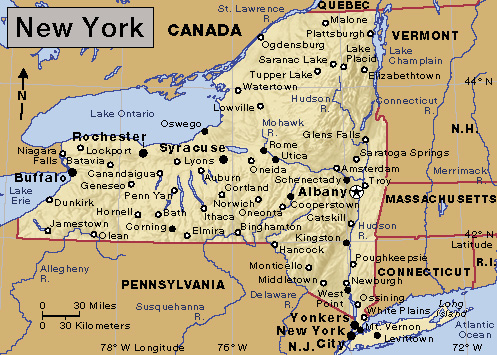Rochester, << ROCH ehs tuhr, >> New York (pop. 211,328; met. area pop. 1,065,361), is a major manufacturing center of the United States. The city also is a leading cultural and commercial center of New York. Rochester ranks as one of the state’s largest cities. It lies in western New York along the Genesee River, near the river’s outlet into Lake Ontario.

Nathaniel Rochester, a businessman from Hagerstown, Maryland, founded Rochester in 1812. He and two associates had purchased 100 acres (40 hectares) of land on the Genesee River in 1803. The abundance of water power and rich soil attracted settlers to the area.
Description.
Rochester, the county seat of Monroe County, covers 37 square miles (96 square kilometers). The Rochester metropolitan area covers 4,908 square miles (12,712 square kilometers). The Genesee River divides the city into two parts of almost equal size. Downtown buildings include the 30-story Innovation Square, formerly known as Xerox Tower; the 27-story marble and bronze Metropolitan, formerly Chase Tower; and a 20-story building that was the former headquarters of Bausch & Lomb.
An elected Board of Education supervises Rochester’s public school system. The city is the home of the University of Rochester and its famous Eastman School of Music. Other institutions of higher learning in the city include Nazareth University, Roberts Wesleyan College, Rochester Institute of Technology, and St. John Fisher University. The Rochester Public Library has a main library and several branches.
The Rochester Philharmonic Orchestra presents programs in the Eastman Theatre, part of the Eastman School of Music. Other attractions in the city include the George Eastman Museum and the Memorial Art Gallery. The Rochester Museum & Science Center includes the Strasenburgh Planetarium. The Strong, a children’s museum, is the home of the National Museum of Play and the National Toy Hall of Fame. The Monroe County Parks System consists of about 20 parks and includes the Seneca Park Zoo.
Economy.
Hospitals and medical research facilities employ many people in the Rochester area. The Eastman Kodak Company, a manufacturer of cameras, printers, and related equipment, has long ranked as one of the city’s chief employers. The city has many manufacturing facilities. Chief products include printers and photocopiers, lenses and other eye care products, industrial machinery, chemicals, plastics, food and food products, automobile parts, clothing, computer and electronic equipment, and tool and die equipment.
Rochester is linked to the Governor Thomas E. Dewey Thruway, the nation’s longest toll superhighway. Passenger and freight trains serve the city. The Frederick Douglass Greater Rochester International Airport is in southwestern Rochester.
Government and history.
Rochester has a strong-mayor form of government, in which the mayor appoints most department heads and has direct control over them. The voters elect the mayor and the nine members of the city council.
Ebenezer Allen, the first European settler in what is now Rochester, arrived in 1789. He built a flour mill on the Genesee River shore for the local Seneca people. The first permanent settlers came in 1812, and the village was incorporated as Rochesterville in 1817. Its name was changed to Rochester in 1822.
Trade flourished after construction of the Erie Canal through Rochester in the mid-1820’s. The canal reduced transportation costs and opened Eastern and Western markets to Rochester farmers and manufacturers. Flour mills multiplied along the Genesee, and Rochester became known as the Flour City.
Rochester received a city charter in 1834. By 1856, the population had grown to about 50,000, and Rochester was called the Flower City as well. One of the city’s many plant nurseries covered 440 acres (178 hectares) and ranked among the largest in the world.
In 1880, George Eastman established a photographic plate-making business in Rochester. His company began to sell Kodak cameras and film in 1888. The company’s success gave Rochester a third nickname, Film City.
During the early 1900’s, the city’s harbor was deepened, and piers and a terminal were expanded. Rochester became an ocean port in 1959 when the St. Lawrence Seaway opened. The seaway lets ships sail inland from the Atlantic Ocean to ports on the Great Lakes.
Major redevelopment projects gave downtown Rochester a new look during the 1960’s and 1970’s. Projects included new shopping malls, offices, hotels, and public parks. In 1985, the Rochester Riverside Convention Center opened. A new baseball stadium opened near the downtown area in 1996.
The city’s population declined from more than 330,000 in 1950 to about 210,000 in 2010. Since the late 1900’s, the decline in jobs provided by such companies as Eastman Kodak and Xerox has presented many challenges to the area’s economy. Rochester’s skilled workforce, however, has attracted many smaller businesses to the area.
